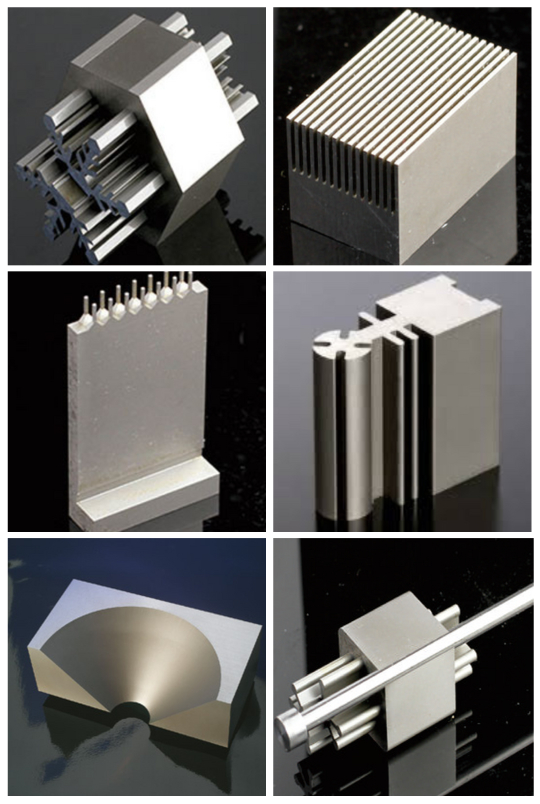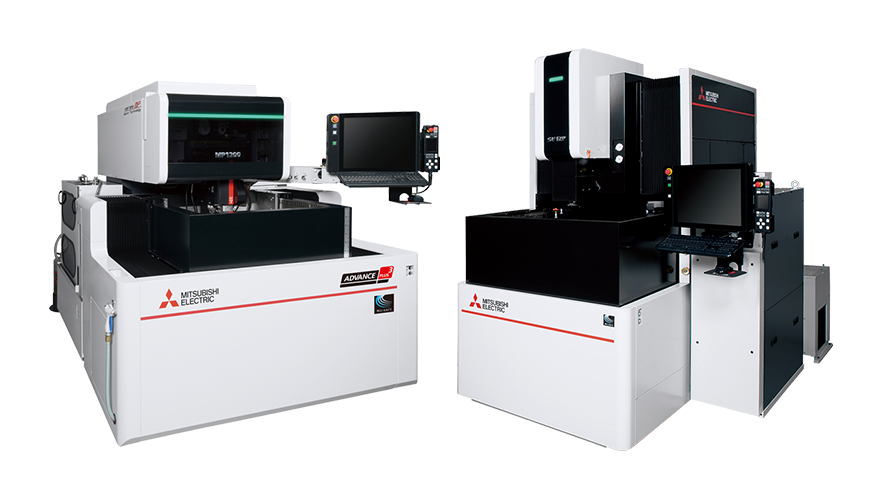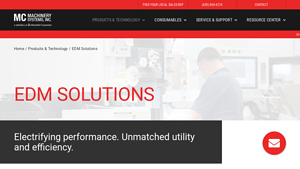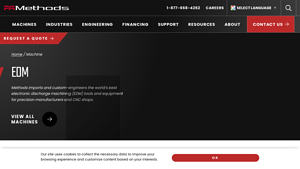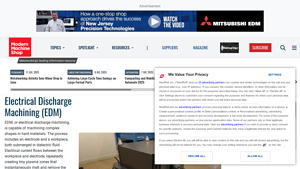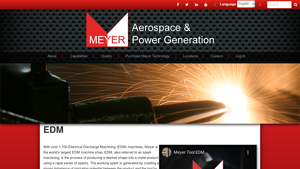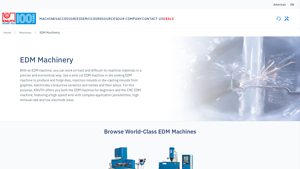Edm Equipment Guide: Type, Cost, Top List…
Introduction: Navigating the Global Market for edm equipment
In today’s rapidly evolving manufacturing landscape, sourcing the right EDM (Electrical Discharge Machining) equipment poses a significant challenge for international B2B buyers. With diverse applications ranging from aerospace to medical device manufacturing, the stakes are high when it comes to precision, efficiency, and cost-effectiveness. This guide aims to demystify the global market for EDM equipment, providing comprehensive insights into various types—such as wire and sinker EDM machines—and their specific applications.
International buyers from regions like Africa, South America, the Middle East, and Europe, including countries like Saudi Arabia and Brazil, will find invaluable information on supplier vetting processes, cost considerations, and the latest technological advancements in automation. Each section is crafted to empower decision-makers by equipping them with the knowledge to navigate the complexities of EDM procurement effectively.
By understanding the intricacies of EDM technology and market trends, buyers can make informed purchasing decisions that not only enhance operational capabilities but also position their businesses competitively in the global marketplace. This guide is your essential resource for unlocking the full potential of EDM equipment, ensuring that you select solutions tailored to your specific manufacturing needs.
Understanding edm equipment Types and Variations
| Type Name | Key Distinguishing Features | Primary B2B Applications | Brief Pros & Cons for Buyers |
|---|---|---|---|
| Wire EDM | Uses a thin wire to cut through materials with high precision. | Aerospace, automotive, medical devices | Pros: Excellent precision and speed; minimal material waste. Cons: Limited to certain materials; requires skilled operators. |
| Sinker EDM | Employs a shaped electrode to create complex geometries. | Molds, dies, aerospace components | Pros: Superior surface finish; ideal for intricate designs. Cons: Slower machining speed; higher initial investment. |
| EDM Automation | Integrates automated systems for loading and unloading workpieces. | High-volume production environments | Pros: Increases efficiency and throughput; reduces labor costs. Cons: Higher setup costs; requires maintenance and training. |
| Hole Drilling EDM | Specializes in creating precise small-diameter holes. | Aerospace, medical implants, precision parts | Pros: Capable of drilling very small and deep holes; minimal thermal impact. Cons: Limited to specific applications; slower than traditional drilling. |
| Multi-Process EDM | Combines wire and sinker EDM capabilities in one machine. | Versatile production settings | Pros: Flexibility to handle diverse tasks; saves space and costs. Cons: Complexity may require specialized training; potential higher maintenance. |
What Are the Characteristics of Wire EDM Equipment?
Wire EDM (Electrical Discharge Machining) utilizes a thin, electrically charged wire to cut through conductive materials with extreme precision. This method is particularly suitable for producing intricate shapes and tight tolerances, making it a preferred choice in industries like aerospace and automotive. Buyers should consider the machine’s speed, ease of use, and maintenance requirements, as these factors directly impact production efficiency and costs. Additionally, understanding the types of materials that can be effectively machined is crucial for ensuring compatibility with project specifications.
How Does Sinker EDM Differ from Other Types?
Sinker EDM employs a shaped electrode that is submerged in a dielectric fluid to create complex geometries in hardened materials. This technology excels in applications requiring high precision and surface finish, such as mold and die production. B2B buyers should evaluate the machine’s capabilities in terms of electrode wear, cycle times, and the types of materials it can process. While this method may involve a higher upfront investment, its ability to produce intricate designs can lead to significant long-term savings through reduced rework and enhanced product quality.
What Benefits Does EDM Automation Offer to Manufacturers?
EDM automation streamlines the machining process by integrating robotic systems for loading and unloading workpieces. This technology is particularly beneficial in high-volume production environments, where efficiency and consistency are paramount. Manufacturers looking to enhance productivity should assess the automation options available, including single and dual machine solutions, as well as the flexibility of robotic systems. While automation can lead to substantial labor cost reductions and improved throughput, it also requires careful planning regarding initial setup costs and ongoing maintenance.
When Is Hole Drilling EDM the Right Choice?
Hole Drilling EDM specializes in creating small-diameter holes with high precision, making it ideal for applications in aerospace and medical devices. This technique minimizes thermal damage to surrounding materials, which is critical when working with sensitive components. B2B buyers should consider the drilling capabilities, including hole size and depth, as well as the machine’s operational costs. Although this method may be slower than traditional drilling, its accuracy and ability to produce complex hole patterns can justify the investment for specialized production needs.
Why Choose Multi-Process EDM Equipment?
Multi-Process EDM machines combine the functionalities of both wire and sinker EDM, offering versatility for various machining tasks. This flexibility can be advantageous for manufacturers who require a range of machining capabilities without investing in multiple machines. Buyers should evaluate the machine’s performance in both wire and sinker modes, as well as its footprint and ease of operation. While the initial investment may be higher, the ability to switch between processes can lead to significant space and cost savings in the long run, making it an attractive option for diverse production settings.
Key Industrial Applications of edm equipment
| Industry/Sector | Specific Application of edm equipment | Value/Benefit for the Business | Key Sourcing Considerations for this Application |
|---|---|---|---|
| Aerospace | Precision component manufacturing | Ensures high accuracy and reliability in critical components. | Look for machines with advanced controls for tight tolerances. |
| Medical Devices | Fabrication of surgical instruments | Provides the precision necessary for intricate and safe designs. | Consider sourcing from suppliers with a strong compliance record. |
| Automotive | Tooling and die production | Enhances production efficiency and reduces lead times. | Evaluate the machine’s automation capabilities to improve throughput. |
| Energy | Custom parts for turbines and generators | Increases operational efficiency and extends equipment lifespan. | Ensure the equipment can handle high-strength materials. |
| Electronics | Production of microelectronic components | Supports the miniaturization trend while maintaining quality. | Assess the machine’s compatibility with various materials and sizes. |
How is EDM Equipment Used in the Aerospace Industry?
In the aerospace sector, EDM equipment is crucial for manufacturing precision components such as turbine blades and landing gear parts. These components often require intricate shapes and tight tolerances, which EDM technology excels at delivering. The ability to work with hard materials while maintaining high accuracy ensures that safety and performance standards are met. For international buyers, sourcing machines with advanced CNC controls and high-speed capabilities is essential to meet stringent aerospace requirements.
What Role Does EDM Equipment Play in Medical Device Manufacturing?
EDM equipment is widely used in the medical device industry for producing surgical instruments and implants. The technology allows for the creation of complex geometries that are often required for effective medical applications. Precision is paramount, as even minor deviations can affect patient safety. Buyers in this field should prioritize suppliers with a proven track record in compliance with medical regulations and standards, ensuring that the equipment can produce safe and effective devices.
How is EDM Equipment Beneficial for Automotive Tooling?
In automotive manufacturing, EDM equipment is utilized for creating tooling and die sets that are essential for mass production. The precision and repeatability of EDM processes contribute to reduced production times and lower costs. Additionally, the ability to use various electrode materials can enhance the durability of the tooling. B2B buyers should consider machines that offer automation features, as these can significantly increase productivity and reduce labor costs.
What Are the Advantages of EDM Equipment in the Energy Sector?
The energy industry relies on EDM equipment for the production of custom parts for turbines, generators, and other critical machinery. The technology’s capability to machine high-strength materials ensures that components can withstand extreme conditions, thereby enhancing efficiency and longevity. For international buyers, it’s crucial to assess the equipment’s adaptability to different material types and its operational efficiency, as these factors can greatly influence overall project success.
How Does EDM Equipment Support Electronics Manufacturing?
In the electronics industry, EDM technology is employed for the production of microelectronic components, such as connectors and circuit boards. The precision of EDM allows for the miniaturization of components, which is increasingly important in modern electronic devices. Buyers should seek machines that can handle various materials and offer flexible configurations to accommodate evolving design requirements. Additionally, sourcing from manufacturers with robust technical support can ensure optimal machine performance in this fast-paced sector.
3 Common User Pain Points for ‘edm equipment’ & Their Solutions
Scenario 1: Struggling with Precision in Complex Components Manufacturing
The Problem: In industries like aerospace and medical devices, manufacturers often face challenges in achieving the necessary precision and surface finish when producing complex components. A B2B buyer may find that traditional machining methods fall short, resulting in parts that do not meet stringent specifications. This not only leads to costly rework but can also delay project timelines, ultimately impacting the bottom line. Moreover, the inability to consistently produce high-precision parts can erode client trust and lead to lost contracts.
The Solution: To overcome these issues, investing in a high-quality Sinker EDM machine can be a game-changer. These machines are specifically designed for tight-tolerance applications, providing unmatched precision for intricate shapes and hardened materials. Buyers should evaluate Sinker EDM models that feature advanced control systems and automation capabilities. For instance, selecting a machine with AI technology can optimize performance while minimizing operator intervention. Furthermore, ensure that you collaborate with reputable suppliers who can offer training and ongoing support to maximize the machine’s potential, thereby ensuring consistent quality in production.
Scenario 2: High Operating Costs and Maintenance Challenges
The Problem: Many B2B buyers encounter significant operating costs associated with EDM equipment, particularly in terms of energy consumption, maintenance, and downtime. This is especially prevalent in regions with fluctuating energy prices or when machinery frequently requires service, which can disrupt production schedules. Buyers may feel pressure to maintain competitive pricing while managing these escalating costs, creating a challenging balancing act.
The Solution: To mitigate these challenges, businesses should focus on sourcing EDM machines known for their energy efficiency and low maintenance requirements. For example, machines that incorporate advanced technology, such as the M800 Series CNC Control, often feature internal designs that reduce wear and tear, thereby extending machine life and minimizing maintenance needs. Additionally, consider integrating EDM automation solutions that enhance throughput and reduce manpower requirements. By optimizing production processes through automation, companies can significantly lower operational costs while improving efficiency and output quality.
Scenario 3: Difficulty in Scaling Production to Meet Market Demand
The Problem: As global markets evolve, B2B buyers often struggle to scale production quickly to meet increasing demand. Whether in Africa, South America, or Europe, the inability to ramp up operations can lead to missed opportunities and dissatisfied customers. Buyers may find their existing EDM equipment inadequate for high-volume production, resulting in delays and a backlog of orders.
The Solution: To effectively scale production, consider investing in EDM automation solutions that enable lights-out manufacturing and increase throughput. Implementing automation cells that can integrate with both Wire and Sinker EDM machines allows for continuous operation without the need for constant oversight. Moreover, buyers should prioritize equipment that offers flexibility and adaptability for various production needs. Engaging with suppliers who provide comprehensive support services, including training on automation systems, will empower teams to leverage these technologies fully. By adopting a strategic approach to scaling, businesses can enhance their competitiveness and responsiveness to market demands.
Strategic Material Selection Guide for edm equipment
What Are the Key Properties of Common Materials Used in EDM Equipment?
When selecting materials for EDM (Electrical Discharge Machining) equipment, it is crucial to consider their properties that directly impact the performance and durability of the machines. Here, we analyze four common materials: Steel, Aluminum, Copper, and Graphite. Each material has distinct characteristics that influence its suitability for various EDM applications.
How Does Steel Perform in EDM Applications?
Steel, particularly tool steel, is widely used in EDM applications due to its excellent hardness and wear resistance. Key properties include high tensile strength and the ability to withstand significant mechanical stress, making it ideal for producing complex shapes and intricate designs. However, steel can be prone to corrosion if not properly treated, which may affect its longevity.
Pros: Steel’s durability and ability to maintain precise tolerances make it a preferred choice for high-stress applications. It is also relatively cost-effective compared to other materials.
Cons: The manufacturing complexity can increase with the need for heat treatment and surface finishing. Additionally, its weight can be a disadvantage in certain applications.
Impact on Application: Steel is compatible with various media and is often used in industries like aerospace and automotive. However, international buyers should ensure compliance with regional standards such as ASTM or DIN to guarantee quality.
What Advantages Does Aluminum Offer for EDM Equipment?
Aluminum is favored for its lightweight nature and excellent machinability. It has good thermal conductivity, which aids in heat dissipation during the EDM process. Additionally, aluminum exhibits decent corrosion resistance, particularly when anodized.
Pros: The lightweight characteristic of aluminum allows for easier handling and installation. Its ability to be machined quickly leads to reduced production times.
Cons: While aluminum is less expensive than some high-grade steels, it has lower tensile strength, which may limit its use in high-stress applications. It is also more susceptible to wear compared to harder materials.
Impact on Application: Aluminum is suitable for applications requiring lightweight components, such as in the aerospace industry. Buyers should consider local preferences for aluminum grades and compliance with standards like JIS or ASTM.
Why is Copper a Preferred Material for EDM Electrode Production?
Copper is frequently used for EDM electrodes due to its superior electrical conductivity and thermal properties. This material allows for efficient energy transfer, which is critical in the EDM process. Copper also offers good wear resistance, particularly when alloyed with other metals.
Pros: The high conductivity of copper leads to faster machining speeds and improved surface finishes. Its resistance to thermal deformation makes it ideal for intricate designs.
Cons: Copper can be more expensive than steel and aluminum, and its softness can lead to higher wear rates during machining. Care must be taken to manage electrode wear.
Impact on Application: Copper is widely used in applications requiring high precision, such as mold making. International buyers should verify compliance with local standards to ensure quality and performance.
What Role Does Graphite Play in EDM Equipment?
Graphite is another popular material for EDM electrodes, particularly in applications requiring high wear resistance and thermal stability. It has excellent machinability and can be produced in various grades to suit specific applications.
Pros: Graphite electrodes can withstand high temperatures without deforming, making them ideal for high-performance EDM applications. They also produce minimal wear on the workpiece.
Cons: While graphite is lightweight, it can be brittle and may require careful handling during production and use. Additionally, it can be more expensive than traditional materials.
Impact on Application: Graphite is particularly effective in complex mold designs and is often preferred in the automotive and aerospace industries. Buyers should ensure that the graphite grades meet international standards for quality assurance.
Summary Table of Material Selection for EDM Equipment
| Material | Typical Use Case for edm equipment | Key Advantage | Key Disadvantage/Limitation | Relative Cost (Low/Med/High) |
|---|---|---|---|---|
| Steel | Tooling and structural components | Excellent hardness and wear resistance | Prone to corrosion if untreated | Medium |
| Aluminum | Lightweight components in aerospace | Lightweight and good machinability | Lower tensile strength | Medium |
| Copper | EDM electrodes for precision machining | Superior electrical conductivity | Higher wear rate and cost | High |
| Graphite | High-performance EDM electrodes | High thermal stability and low wear | Brittle and requires careful handling | High |
This guide provides B2B buyers with actionable insights into the strategic selection of materials for EDM equipment, ensuring they make informed decisions that align with their operational requirements and regional standards.
In-depth Look: Manufacturing Processes and Quality Assurance for edm equipment
What Are the Main Stages of Manufacturing EDM Equipment?
The manufacturing of Electrical Discharge Machining (EDM) equipment involves several critical stages: material preparation, forming, assembly, and finishing. Each of these stages is vital to ensure that the final product meets the high precision and reliability standards demanded by industries such as aerospace, automotive, and medical device manufacturing.
How Is Material Prepared for EDM Equipment?
The first stage in the manufacturing process is material preparation. High-quality raw materials, typically high-grade tool steel or specialized alloys, are selected based on the specific requirements of the EDM equipment being produced. This phase may involve cutting the materials to size and performing surface treatments to enhance their machinability. Precision in this stage is crucial, as any defects in the raw materials can lead to significant issues later in the production process.
What Forming Techniques Are Commonly Used in EDM Equipment Manufacturing?
Forming is the next critical stage, where the prepared materials are shaped into components of the EDM machines. Techniques such as machining, grinding, and electrical discharge machining itself are commonly employed. CNC machining centers are often used for their ability to achieve tight tolerances and complex geometries, which are essential for the intricate components of EDM systems. This stage may also involve the application of advanced technologies, including additive manufacturing, to create complex parts that would be challenging to produce using traditional methods.
How Is Assembly Conducted in EDM Equipment Manufacturing?
The assembly stage combines the various components produced during the forming phase. Skilled technicians and engineers work meticulously to ensure that all parts fit together perfectly, which is crucial for the machine’s performance and longevity. During assembly, rigorous checks are performed to confirm that all components meet design specifications. Automated assembly systems may also be used to enhance efficiency and precision, particularly in high-volume production environments.
What Finishing Processes Are Applied to EDM Equipment?
Finishing processes are the final step in the manufacturing of EDM equipment. These processes often include surface treatment techniques such as polishing, coating, and heat treatment to enhance the performance and durability of the machines. For instance, coatings may be applied to reduce wear and tear, while heat treatment can increase the material’s hardness. Quality checks during this stage ensure that the machines not only meet aesthetic standards but also perform reliably under operational conditions.
What Quality Assurance Standards Are Relevant for EDM Equipment?
Quality assurance (QA) is a critical aspect of EDM equipment manufacturing, especially for international B2B buyers who demand high standards. Various international standards guide the QA processes, with ISO 9001 being one of the most recognized. This standard focuses on quality management systems and emphasizes customer satisfaction, process consistency, and continuous improvement.
In addition to ISO standards, industry-specific certifications such as CE marking (indicating conformity with health, safety, and environmental protection standards) and API (American Petroleum Institute) certifications may be relevant, especially for equipment used in the oil and gas sectors. These certifications provide additional assurance of quality and compliance with international regulations.
How Are Quality Control Checkpoints Structured in EDM Equipment Manufacturing?
Quality control (QC) checkpoints are strategically implemented throughout the manufacturing process to ensure that every component and the final product meet the required standards. Common QC checkpoints include:
- Incoming Quality Control (IQC): This stage involves inspecting raw materials upon receipt to ensure they meet specified standards before they are used in production.
- In-Process Quality Control (IPQC): During the manufacturing process, various tests and inspections are conducted to monitor quality and performance at each stage. This proactive approach helps identify and rectify any issues before they escalate.
- Final Quality Control (FQC): Once the equipment is assembled, a thorough inspection is conducted to ensure that it meets all specifications and standards. This may include functional testing, dimensional checks, and performance evaluations.
What Common Testing Methods Are Utilized in EDM Equipment Manufacturing?
Several testing methods are commonly employed to verify the quality and performance of EDM equipment. These may include:
- Dimensional Inspection: Using precision measurement tools such as calipers and coordinate measuring machines (CMM) to ensure that components meet specified dimensions.
- Functional Testing: Assessing the operational capabilities of the EDM machine under various conditions to ensure reliability and performance.
- Non-Destructive Testing (NDT): Techniques such as ultrasonic testing or magnetic particle inspection are used to identify internal flaws without damaging the components.
- Performance Testing: Involves running the machine under load to evaluate its efficiency, speed, and ability to maintain precision.
How Can B2B Buyers Verify Supplier Quality Control Processes?
For international B2B buyers, verifying the QC processes of potential suppliers is crucial. Here are several methods to ensure that suppliers adhere to stringent quality standards:
- Supplier Audits: Conducting on-site audits of the manufacturing facility allows buyers to evaluate the supplier’s processes, equipment, and quality management systems firsthand.
- Quality Reports: Requesting detailed quality reports, including inspection and testing results, can provide insights into the supplier’s QC practices and performance history.
- Third-Party Inspections: Engaging independent third-party inspection services can offer an unbiased assessment of the supplier’s compliance with international quality standards.
What Are the Quality Control Nuances for International B2B Buyers?
International buyers, particularly those from regions like Africa, South America, the Middle East, and Europe, must be aware of specific nuances in QC practices. Differences in regulatory standards, cultural expectations regarding quality, and logistical considerations can all impact procurement decisions.
- Regulatory Compliance: Buyers should familiarize themselves with the local regulations and standards that apply to EDM equipment in their respective countries. This knowledge can help ensure that imported equipment meets local compliance requirements.
- Cultural Expectations: Understanding the quality expectations and communication styles of suppliers from different regions can facilitate smoother negotiations and foster long-term partnerships.
- Logistics and Supply Chain Considerations: Buyers should consider how quality assurance practices are maintained throughout the supply chain, especially when dealing with international shipments. This includes understanding how materials are handled and transported, as well as the potential for delays that could impact quality.
By being proactive and informed about the manufacturing processes and quality assurance measures in EDM equipment production, B2B buyers can make more strategic purchasing decisions and ensure they receive high-quality products that meet their operational needs.
Practical Sourcing Guide: A Step-by-Step Checklist for ‘edm equipment’
Introduction
In the rapidly evolving landscape of electronic discharge machining (EDM) equipment, international B2B buyers face the challenge of making informed procurement decisions. This guide provides a step-by-step checklist to streamline the sourcing process, ensuring that you select high-quality EDM machines that meet your operational needs while optimizing productivity and cost-effectiveness.
Step 1: Define Your Technical Specifications
Clearly articulating your technical requirements is essential before engaging with suppliers. Consider aspects such as the type of EDM (wire or sinker), the material you will be machining, and the desired tolerances and finishes. This foundational step will help you filter potential equipment options and align them with your manufacturing goals.
- Material Compatibility: Ensure the EDM equipment can handle the types of materials you typically work with, especially hardened materials requiring precise machining.
- Tolerances and Finishes: Specify the tolerances and surface finishes your applications demand to avoid future disappointments.
Step 2: Research Leading Manufacturers
Take the time to identify and research reputable manufacturers known for their EDM technology. Look for companies with a proven track record of innovation, reliability, and customer satisfaction in the EDM market. This will significantly reduce the risk of procuring subpar equipment.
- Industry Reputation: Review online forums, industry publications, and customer testimonials to gauge each manufacturer’s standing in the market.
- Technology Advancements: Consider manufacturers that invest in R&D and offer the latest technology, such as AI-enhanced controls or automation solutions.
Step 3: Evaluate Potential Suppliers
Before committing, it’s crucial to vet suppliers thoroughly. Request company profiles, case studies, and references from buyers in a similar industry or region. Don’t just rely on their website; engage directly with their sales representatives to assess their responsiveness and expertise.
- Request Samples: If possible, obtain samples of their previous work or visit their facilities to see the machines in action.
- Check Certifications: Verify that the supplier meets international standards and certifications, ensuring compliance with safety and quality regulations.
Step 4: Compare Pricing and Total Cost of Ownership
While initial pricing is important, it’s equally vital to consider the total cost of ownership (TCO), including maintenance, operational costs, and potential downtime. Request detailed quotations that break down these costs, allowing for a clearer comparison between suppliers.
- Maintenance Costs: Assess the availability of spare parts and the expected frequency of maintenance to avoid unforeseen expenses.
- Operational Efficiency: Evaluate the machine’s performance metrics, such as speed and energy consumption, to project long-term savings.
Step 5: Assess After-Sales Support and Training
After-sales support can significantly impact your operational efficiency. Ensure that the supplier offers comprehensive training for your team and reliable technical support for troubleshooting and maintenance.
- Training Programs: Look for suppliers that provide hands-on training to ensure your operators can maximize the machine’s capabilities.
- Technical Support: Confirm the availability of support services, including remote assistance and on-site visits, to address any potential issues swiftly.
Step 6: Negotiate Terms and Finalize Contracts
Once you’ve selected a supplier, engage in negotiations to finalize the terms of purchase. Be clear about your expectations concerning delivery timelines, payment terms, and warranty coverage.
- Warranties: Ensure that warranties cover critical components and that you understand the terms regarding service and repairs.
- Payment Flexibility: Discuss payment options that suit your cash flow requirements, such as installment plans or financing options.
By following this structured sourcing guide, B2B buyers can make informed decisions that lead to successful procurement of EDM equipment, ultimately enhancing productivity and competitiveness in their respective markets.
Comprehensive Cost and Pricing Analysis for edm equipment Sourcing
What Are the Key Cost Components in EDM Equipment Sourcing?
When sourcing EDM (Electrical Discharge Machining) equipment, understanding the cost structure is crucial for international B2B buyers. The cost components typically include:
-
Materials: The quality and type of materials used in manufacturing EDM machines significantly impact costs. High-grade metals and components often lead to higher prices but can enhance durability and performance.
-
Labor: Labor costs vary by region and can influence the overall price. Skilled labor is necessary for both the manufacturing and assembly processes, particularly for precision machinery like EDM.
-
Manufacturing Overhead: This includes costs associated with production facilities, utilities, and administrative expenses. Efficient manufacturing processes can lower overhead, thus reducing the final price of the equipment.
-
Tooling: Tooling costs encompass the expenses associated with molds, dies, and other production tools necessary for manufacturing EDM machines. Custom tooling can lead to higher costs but is often required for specialized applications.
-
Quality Control (QC): Ensuring that EDM machines meet industry standards requires investments in quality control processes. Comprehensive QC measures can add to the overall cost but are essential for maintaining reliability and performance.
-
Logistics: Shipping and handling costs can be significant, especially for large machinery. Factors such as the distance from the manufacturer, shipping method, and Incoterms can all influence logistics costs.
-
Margin: Suppliers will include their profit margin in the final pricing. Understanding typical margins in the EDM industry can help buyers gauge whether a quote is reasonable.
What Influences Pricing in EDM Equipment Sourcing?
Several factors can influence pricing in the EDM equipment market:
-
Volume/MOQ: Bulk orders often attract discounts. Buyers should negotiate minimum order quantities (MOQ) to achieve better pricing.
-
Specifications/Customization: Custom features can increase costs. Buyers should clearly define specifications to avoid unexpected expenses.
-
Materials: The choice of materials can significantly affect pricing. High-performance materials might be more expensive but can result in lower operational costs due to enhanced durability.
-
Quality and Certifications: Equipment with higher quality standards and certifications often comes at a premium but can provide greater assurance of performance and reliability.
-
Supplier Factors: The reputation, reliability, and geographic location of suppliers can impact pricing. Established suppliers may offer better warranties and support, justifying a higher price.
-
Incoterms: Understanding the terms of delivery (Incoterms) is essential as they dictate who bears the cost and risk at each stage of the shipping process. This can affect the total landed cost.
How Can Buyers Optimize Costs When Sourcing EDM Equipment?
B2B buyers can implement several strategies to enhance cost-efficiency in their EDM equipment sourcing:
-
Negotiation: Building strong relationships with suppliers can lead to better pricing and terms. Being prepared with market research can empower buyers during negotiations.
-
Total Cost of Ownership (TCO): Assessing TCO, which includes purchase price, maintenance, operational costs, and potential downtime, can lead to smarter purchasing decisions. A lower upfront cost may not always translate to lower TCO.
-
Pricing Nuances for International Buyers: Buyers from regions such as Africa, South America, the Middle East, and Europe should be aware of currency fluctuations, import tariffs, and local regulations that can affect pricing. Engaging local experts or consultants can provide valuable insights.
What Should Buyers Keep in Mind Regarding Pricing Estimates?
It is essential for buyers to approach pricing estimates with a degree of caution. Prices can vary significantly based on the aforementioned factors, and quotes should be viewed as indicative rather than definitive. Buyers should request detailed breakdowns of costs to understand what is included in the quoted price and to facilitate better comparisons among different suppliers.
Alternatives Analysis: Comparing edm equipment With Other Solutions
Exploring Alternatives to EDM Equipment for Precision Manufacturing
In the realm of precision manufacturing, Electronic Discharge Machining (EDM) equipment is a popular choice for creating complex shapes with high accuracy. However, businesses must consider alternative solutions that may better suit their specific needs, particularly in diverse international markets. This analysis compares EDM equipment with two viable alternatives: CNC machining and laser cutting. Each solution has unique advantages and disadvantages that can influence a buyer’s decision.
Comparison Table
| Comparison Aspect | EDM Equipment | CNC Machining | Laser Cutting |
|---|---|---|---|
| Performance | High precision, excellent surface finish | Versatile, good for a variety of materials | Fast processing, ideal for thin materials |
| Cost | High initial investment, low operating costs | Moderate initial investment, moderate operating costs | Lower initial investment, high operating costs for certain materials |
| Ease of Implementation | Requires skilled operators, longer setup time | Familiar technology, relatively easy to implement | User-friendly, quick setup with less training required |
| Maintenance | Regular maintenance needed for precision | Moderate maintenance, depending on complexity | Low maintenance, few moving parts |
| Best Use Case | Complex parts, hard materials, tight tolerances | General-purpose machining, high-volume production | Cutting thin materials, fast prototyping |
Detailed Breakdown of Alternatives
CNC Machining
CNC (Computer Numerical Control) machining is a widely adopted method in various industries for producing parts with complex geometries. It operates by removing material from a solid block using rotating cutting tools.
Pros: CNC machines offer versatility, enabling manufacturers to work with a wide range of materials, including metals, plastics, and composites. They provide good precision and can be programmed for various designs, making them suitable for both prototyping and mass production.
Cons: While CNC machining is effective for many applications, it may not achieve the same level of precision as EDM, especially for intricate shapes or very hard materials. Additionally, setup times can be longer, and tooling costs may accumulate over time.
Laser Cutting
Laser cutting employs focused laser beams to melt, burn, or vaporize materials, allowing for precise cuts and intricate designs.
Pros: One of the standout benefits of laser cutting is its speed; it can quickly process thin materials with high accuracy. The technology requires minimal tooling and offers a clean finish, reducing the need for secondary operations. It is particularly advantageous for rapid prototyping and low-volume production runs.
Cons: While laser cutting is efficient, it has limitations regarding material thickness and types. It is less effective on thicker materials and may not achieve the same quality of finish on certain metals as EDM does. Operating costs can be high due to energy consumption and potential lens replacements.
Conclusion: How to Choose the Right Solution for Your Needs
When evaluating EDM equipment against alternatives like CNC machining and laser cutting, B2B buyers should consider specific project requirements, budget constraints, and operational capabilities. EDM equipment excels in precision and is ideal for complex, high-tolerance parts, while CNC machining offers versatility for a broader range of applications. Laser cutting shines in speed and efficiency for thinner materials.
Ultimately, the best choice will depend on the specific manufacturing needs, including the types of materials processed, production volumes, and desired tolerances. By carefully analyzing these factors, buyers can make informed decisions that align with their operational goals and market demands.
Essential Technical Properties and Trade Terminology for edm equipment
What Are the Critical Technical Properties of EDM Equipment?
When considering EDM (Electrical Discharge Machining) equipment, it’s essential to understand several critical technical specifications that impact performance, efficiency, and cost-effectiveness. Here are some key properties:
-
Material Grade
– The grade of materials used in EDM machines affects durability and performance. High-grade materials reduce wear and tear, leading to longer machine life and lower maintenance costs. For B2B buyers, investing in machines with superior material quality can result in significant long-term savings and reliability. -
Tolerance
– Tolerance refers to the allowable deviation from a specified dimension. In EDM, tolerances can be as tight as ±0.0001 inches (±0.00254 mm). High precision is crucial for industries like aerospace and medical where safety and functionality are paramount. Understanding tolerance levels helps buyers select machines that meet their specific production requirements. -
Surface Finish
– The surface finish of machined parts is vital for aesthetic and functional reasons. EDM processes can achieve finishes as fine as 4Ra, which is critical for applications that require smooth surfaces to minimize friction or enhance appearance. Buyers should consider the surface finish capabilities when evaluating machines for high-end applications. -
Machining Speed
– This is the rate at which a machine can remove material, often measured in inches per minute (IPM). Faster machining speeds can significantly improve productivity, allowing manufacturers to increase output and reduce lead times. For B2B buyers, understanding the trade-off between speed and accuracy is essential for optimizing production efficiency. -
Automation Capabilities
– EDM machines equipped with automation features, such as robotic loading and unloading, can dramatically enhance throughput and reduce labor costs. Automation also minimizes human error, leading to more consistent production quality. Buyers should assess the level of automation available to maximize operational efficiency. -
Tank Capacity
– The tank capacity of an EDM machine determines the size of parts it can handle. Larger tanks allow for the machining of bigger components, which is crucial for industries like automotive and aerospace. Understanding tank size requirements helps buyers select machines that align with their production needs.
What Are Common Trade Terms in the EDM Industry?
Familiarity with industry jargon is critical for effective communication and negotiation in the EDM equipment market. Here are some commonly used terms:
-
OEM (Original Equipment Manufacturer)
– An OEM refers to a company that produces parts or equipment that may be marketed by another manufacturer. In the EDM context, understanding whether a machine is sourced from an OEM can affect parts availability and service agreements. Buyers should consider OEM reputation when selecting equipment. -
MOQ (Minimum Order Quantity)
– MOQ is the smallest quantity of a product that a supplier is willing to sell. Understanding MOQ is essential for B2B buyers as it can impact inventory management and cash flow. Buyers should negotiate MOQs that align with their production needs to avoid excess stock. -
RFQ (Request for Quotation)
– An RFQ is a document sent to suppliers to request pricing and terms for specific products or services. Issuing an RFQ allows buyers to compare offers and negotiate better deals. This process is vital for ensuring competitive pricing in the procurement of EDM equipment. -
Incoterms (International Commercial Terms)
– Incoterms are internationally recognized rules that define the responsibilities of buyers and sellers in the shipping process. They clarify who is responsible for shipping, insurance, and tariffs. Familiarity with Incoterms helps buyers avoid unexpected costs and ensures smooth transactions. -
Lead Time
– Lead time refers to the time it takes from placing an order to receiving the product. Understanding lead times is crucial for B2B buyers to manage production schedules and avoid delays. Buyers should inquire about lead times when evaluating suppliers to ensure timely delivery. -
TCO (Total Cost of Ownership)
– TCO encompasses all costs associated with the purchase and use of equipment, including acquisition costs, maintenance, and operational expenses. Understanding TCO helps buyers make informed decisions by considering long-term value rather than just upfront costs.
By grasping these essential properties and terms, B2B buyers can navigate the EDM equipment market more effectively, ensuring they make informed decisions that align with their operational goals.
Navigating Market Dynamics and Sourcing Trends in the edm equipment Sector
What Are the Current Market Dynamics and Key Trends in the EDM Equipment Sector?
The EDM equipment sector is experiencing significant transformation driven by technological advancements and evolving market demands. Key global drivers include the increasing need for precision manufacturing across industries such as aerospace, automotive, and medical devices. The rise of automation technology is reshaping production processes, allowing manufacturers to enhance efficiency and reduce operational costs. For international B2B buyers, particularly those from Africa, South America, the Middle East, and Europe, understanding these dynamics is crucial for effective sourcing strategies.
Emerging trends in B2B tech include the integration of artificial intelligence (AI) and IoT (Internet of Things) within EDM machines. These technologies facilitate predictive maintenance, optimize machining processes, and improve overall production quality. Additionally, automation solutions, such as robotic loading systems and automated palletization, are becoming essential for companies looking to maximize throughput and minimize labor costs. The demand for high-precision and high-volume capabilities is prompting manufacturers to invest in advanced EDM solutions that can deliver superior performance while maintaining low operating costs.
Moreover, international buyers are increasingly seeking suppliers who can provide customized solutions tailored to their specific requirements. This shift towards personalization in product offerings is coupled with a growing emphasis on sustainability, pushing manufacturers to adopt greener practices in their production processes. Understanding these market dynamics and sourcing trends enables B2B buyers to make informed decisions and stay competitive in a rapidly evolving landscape.
How Is Sustainability and Ethical Sourcing Influencing the EDM Equipment Sector?
The environmental impact of manufacturing processes is a pressing concern for many industries, including EDM equipment. As global awareness of climate change and resource depletion rises, the demand for sustainable and ethically sourced products is becoming more pronounced. B2B buyers are increasingly prioritizing suppliers who demonstrate a commitment to sustainability in their operations, which includes responsible sourcing of materials, energy-efficient manufacturing practices, and waste reduction initiatives.
Ethical supply chains are essential in the EDM sector, as they not only contribute to environmental conservation but also enhance brand reputation and customer loyalty. Buyers are encouraged to look for manufacturers that hold green certifications, such as ISO 14001, which indicates a robust environmental management system. Additionally, the use of eco-friendly materials in EDM production can significantly reduce the carbon footprint associated with these products.
Investing in sustainable EDM equipment can also lead to long-term cost savings for businesses. By focusing on energy-efficient machines and processes, companies can reduce operational expenses while meeting regulatory requirements and customer expectations for environmentally responsible practices. For international B2B buyers, aligning sourcing decisions with sustainability goals is not just beneficial for the planet; it is also a strategic move to enhance competitiveness in the marketplace.
What Is the Brief Evolution and History of EDM Equipment?
The evolution of EDM (Electrical Discharge Machining) equipment dates back to the 1940s when it was first developed as a method for machining hard metals that were otherwise difficult to shape using conventional machining techniques. Initially utilized in the aerospace and defense industries, EDM technology gained traction due to its ability to produce intricate shapes and tight tolerances with minimal human intervention.
As the technology advanced, the introduction of wire EDM and sinker EDM machines marked significant milestones in the sector, allowing for increased efficiency and precision. The 1980s and 1990s saw the integration of computer numerical control (CNC) systems, which further revolutionized EDM by enhancing automation and repeatability. Today, with the advent of AI and IoT, the EDM equipment landscape continues to evolve, offering unprecedented levels of performance and operational efficiency.
This historical context is essential for B2B buyers, as it highlights the continuous innovation within the EDM sector and the importance of selecting suppliers who are at the forefront of these technological advancements. Understanding the trajectory of EDM equipment can guide buyers in making informed decisions that align with their operational goals and future growth strategies.
Frequently Asked Questions (FAQs) for B2B Buyers of edm equipment
-
How do I choose the right EDM equipment for my business needs?
Selecting the appropriate EDM equipment involves assessing your specific production requirements. Consider factors such as the type of materials you work with, the complexity of parts, and required tolerances. For instance, if you need to machine hard materials with intricate shapes, a Sinker EDM might be more suitable. Alternatively, if speed and efficiency are paramount, a Wire EDM could be the right choice. Additionally, evaluate the machine’s automation capabilities, as these can significantly enhance throughput and reduce labor costs. -
What is the best EDM machine for small-scale production?
For small-scale production, the Mitsubishi MX600 Advance Plus Wire EDM is highly recommended. It offers a balance of performance and cost-effectiveness, making it ideal for businesses that need precise machining without excessive investment. This model is user-friendly, has low operating costs, and can achieve tight tolerances, making it a versatile choice for various applications. Always consider your specific production volume and part complexity when making a selection. -
What are the typical lead times for EDM equipment orders?
Lead times for EDM equipment can vary significantly depending on the manufacturer, model, and customization requirements. Generally, standard models may take 4 to 8 weeks for delivery, while customized machines can take up to 12 weeks or more. It’s crucial to communicate your timelines with suppliers early in the procurement process to ensure that your production schedules are not disrupted. Additionally, inquire about potential delays due to international shipping or customs clearance. -
How can I vet suppliers of EDM equipment?
Vetting suppliers is essential to ensure quality and reliability. Start by researching their reputation in the industry through reviews and testimonials from previous clients. Request references and assess their experience in your specific market. Evaluate their after-sales support, warranty terms, and service capabilities. Additionally, check their compliance with international standards and certifications, which can indicate their commitment to quality and safety. -
What are the minimum order quantities (MOQs) for EDM equipment?
Minimum order quantities can vary widely among suppliers. Some manufacturers may allow for the purchase of single machines, while others may set MOQs based on production runs or bundled equipment. When negotiating, consider discussing your specific needs and potential future orders, as some suppliers may be flexible with MOQs for long-term partnerships. Always clarify these terms before finalizing any agreements to avoid unexpected costs. -
What payment terms should I expect when purchasing EDM equipment?
Payment terms for EDM equipment purchases typically vary by supplier and can include options like upfront payments, installments, or letters of credit. Many suppliers require a deposit upon order confirmation, with the balance due before shipment. It’s advisable to discuss and negotiate payment terms that align with your cash flow and project timelines. Ensure that all terms are documented in the purchase agreement to avoid misunderstandings. -
How is quality assurance handled for EDM equipment?
Quality assurance for EDM equipment is typically managed through rigorous testing and inspection processes by manufacturers. Ensure that your supplier provides documentation on their quality control measures, including certifications such as ISO standards. Request information on the testing procedures for the machines you are purchasing, and inquire about warranties and service agreements, which can provide additional assurance of equipment reliability and performance. -
What logistics considerations should I keep in mind when importing EDM equipment?
Importing EDM equipment involves several logistics considerations, including shipping methods, customs clearance, and local regulations. Choose a reliable freight forwarder familiar with handling industrial machinery to ensure safe and timely delivery. Be prepared to manage import duties and tariffs, which can significantly affect your total cost. Additionally, ensure that you have the necessary documentation, such as commercial invoices and packing lists, to facilitate smooth customs processing upon arrival.
Important Disclaimer & Terms of Use
⚠️ Important Disclaimer
The information provided in this guide, including content regarding manufacturers, technical specifications, and market analysis, is for informational and educational purposes only. It does not constitute professional procurement advice, financial advice, or legal advice.
While we have made every effort to ensure the accuracy and timeliness of the information, we are not responsible for any errors, omissions, or outdated information. Market conditions, company details, and technical standards are subject to change.
B2B buyers must conduct their own independent and thorough due diligence before making any purchasing decisions. This includes contacting suppliers directly, verifying certifications, requesting samples, and seeking professional consultation. The risk of relying on any information in this guide is borne solely by the reader.
Top 7 Edm Equipment Manufacturers & Suppliers List
1. MC Machinery – EDM Solutions
Domain: mcmachinery.com
Registered: 1998 (27 years)
Introduction: EDM Solutions include Wire and Sinker EDM Machines. Wire EDM simplifies part production with excellent tolerances and minimal manpower. Sinker EDM provides highly repeatable technology for complex shapes and hardened materials with excellent accuracy and surface finishes. Key Wire EDM models include: 1. MX600 Advance Plus – cost-effective for small/production applications. 2. MV1200-S Advance Type…
2. Methods – FANUC RoboCut Wire EDM Series
Domain: methodsmachine.com
Registered: 1996 (29 years)
Introduction: Methods imports and custom-engineers electronic discharge machining (EDM) tools and equipment for precision manufacturers and CNC shops. Key products include: 1. FANUC RoboCut C400iC Wire EDM 2. FANUC RoboCut C600iC Wire EDM 3. FANUC RoboCut C800iB-20 Wire EDM 4. FANUC RoboCut C800iC Wire EDM. These machines are designed to provide advanced machining solutions that enhance business growth.
3. Seibu – M35B-AWF 9 CNC Wire EDM
Domain: alternativemachinetool.com
Registered: 2001 (24 years)
Introduction: EDM machines for sale include Wire EDM, hole drillers, and RAM type EDM machines. Key products listed are: 1. Seibu M35B-AWF 9″” CNC Wire EDM – New, Demo Price: $123,400.00 (Reg. $144,000.00) 2. Used Fanuc 1iA-SAWF CNC Wire EDM – Condition: Good, Price: $29,500.00 3. Used Fanuc 0iB-SAWF 7″” CNC Wire EDM – Condition: Very Good, Price: $24,900.00 4. Like New Fanuc 1iD-16″” Z Wire EDM – Condition: Li…
4. MMSONLINE – Electrical Discharge Machining Solutions
Domain: mmsonline.com
Registered: 1997 (28 years)
Introduction: This company, MMSONLINE – Electrical Discharge Machining Solutions, is a notable entity in the market. For specific product details, it is recommended to visit their website directly.
5. Belmont Equipment – EDM Solutions
Domain: info.belmont4edm.com
Registered: 1997 (28 years)
Introduction: Belmont Equipment & Technologies specializes in EDM (Electrical Discharge Machining) solutions, offering a comprehensive range of products and services since 1960. Key offerings include custom-built and turn-key EDM machines, Sinker EDM Machines, Small Hole EDM Drills, Roughing End Mills, Specialized EDM Wire, Standard & Premium EDM Tubing, and EDM Graphite. They emphasize efficiency and productiv…
6. Meyer Tool – Multi Axis Fast-Hole EDM
Domain: meyertool.com
Registered: 1996 (29 years)
Introduction: Meyer Tool is the world’s largest EDM machine shop with over 1,100 EDM machines. Key offerings include: 1. Multi Axis Fast-Hole EDM: – Over 800 CNC Small Hole Drillers – Over 400 Conventional Sinker EDM – Average of 1.7 million cooling holes per day for the gas turbine engine industry – Hole diameter precision of ±.0005″ and internal flow measurements within ±3% of nominal – Capability of machinin…
7. Knuth – EDM Machines
Domain: knuth.com
Registered: 1996 (29 years)
Introduction: EDM (Electrical Discharge Machining) machines from Knuth are designed for precision machining of hard materials. They offer features such as high-speed machining, user-friendly controls, and robust construction. The machines are suitable for various applications including mold making and tool production. Key specifications include adjustable machining parameters, a range of electrode materials, an…
Strategic Sourcing Conclusion and Outlook for edm equipment
What Are the Key Insights for Sourcing EDM Equipment?
In today’s competitive landscape, strategic sourcing of EDM equipment is essential for optimizing production efficiency and maintaining high-quality standards. Buyers should prioritize machines that offer advanced automation features, ensuring reduced manpower and improved throughput. Understanding the specific capabilities of wire and sinker EDM machines can help organizations tailor their sourcing decisions to meet unique operational demands, especially in industries requiring precision and repeatability, such as aerospace, medical, and automotive.
How Can Buyers Leverage Strategic Sourcing for Competitive Advantage?
Investing in high-performance EDM technology not only enhances productivity but also drives down operational costs over time. For international buyers, particularly in Africa, South America, the Middle East, and Europe, forging partnerships with reputable suppliers can unlock access to cutting-edge equipment and support services. By aligning sourcing strategies with the latest innovations, businesses can position themselves for long-term growth and sustainability in an evolving market.
What Should You Do Next?
As you consider your sourcing strategy for EDM equipment, take proactive steps to engage with suppliers who demonstrate a commitment to quality and technological advancement. By doing so, you will ensure that your operations remain competitive and poised for success in the global marketplace. Now is the time to act—invest in the future of your manufacturing capabilities and elevate your business to new heights.
